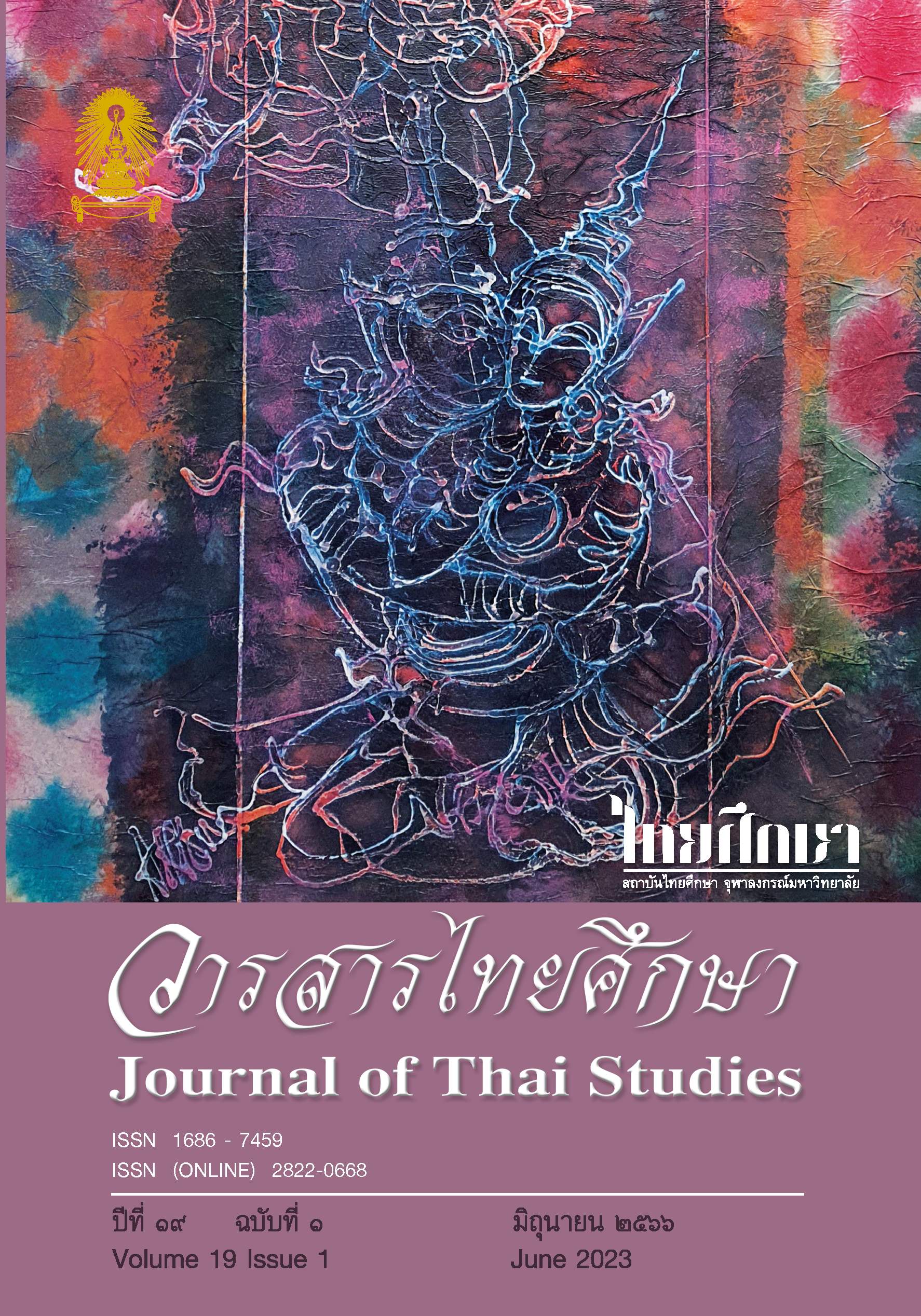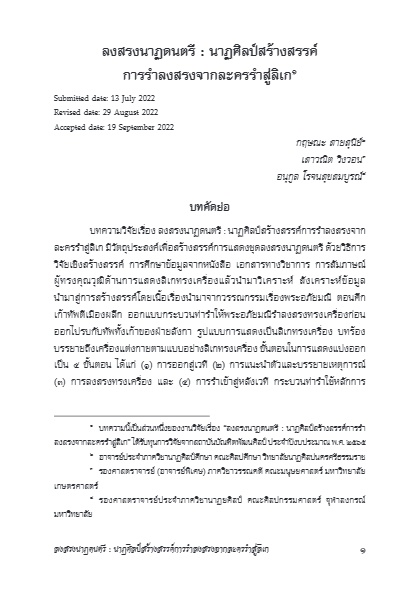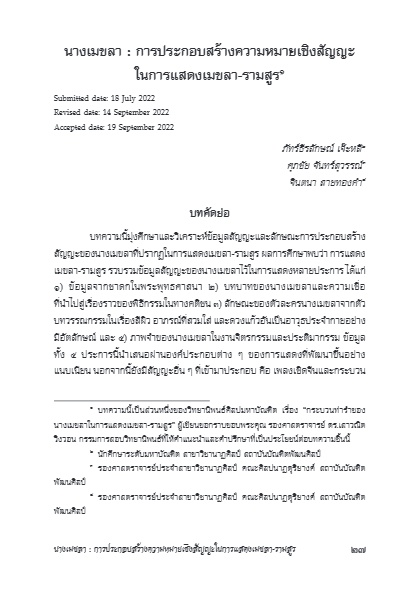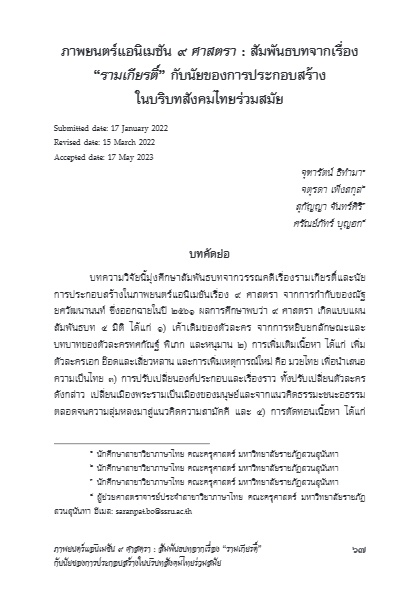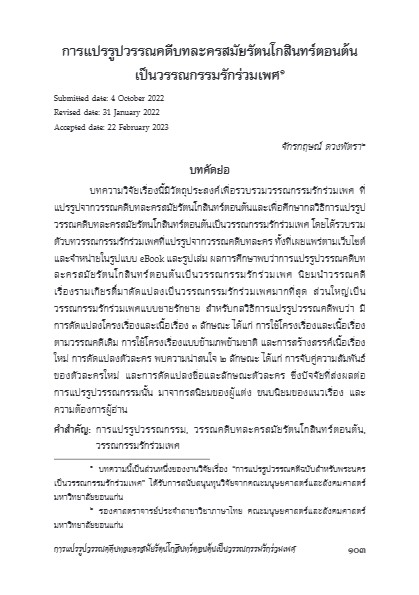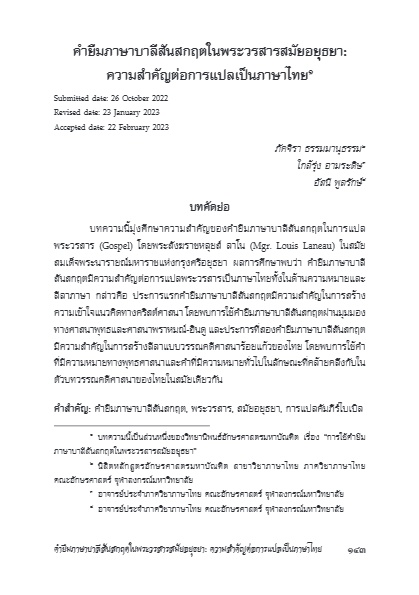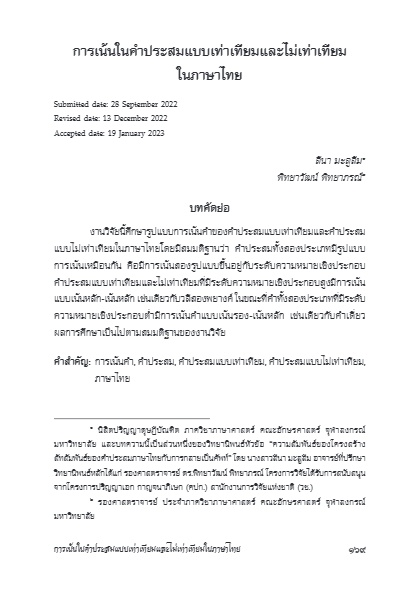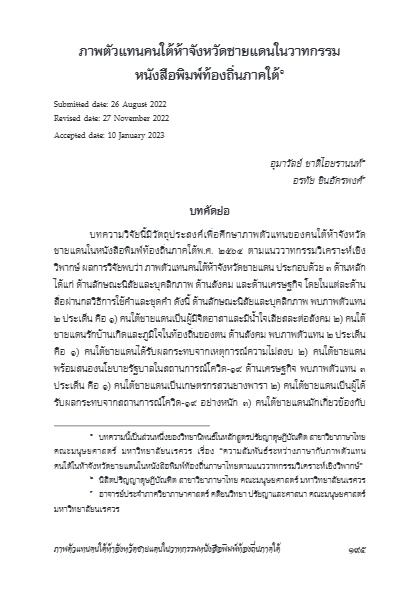วารสารไทยศึกษาปีที่ 19 ฉบับที่ 1

1) ลงสรงนาฏดนตรี : นาฏศิลป์สร้างสรรค์การรำลงสรงจากละครรำสู่ลิเก/กฤษณะ สายสุนีย์ เสาวณิต วิงวอน อนุกูล โรจนสุขสมบูรณ์
2) นางเมขลา : การประกอบสร้างความหมายเชิงสัญญะในการแสดงเมขลา-รามสูร / ภัทร์ธีรลักษณ์ เจ๊ะหลี
ศุภชัย จันทร์สุวรรณ์ จินตนา สายทองคำ
3) ภาพยนตร์แอนิเมชัน ๙ ศาสตรา : สัมพันธบทจากเรื่อง“รามเกียรติ์” กับนัยของการประกอบสร้าง
ในบริบทสังคมไทยร่วมสมัย / จุฑารัตน์ ธิทำมา จตุรดา เพ็งสกุล สุกัญญา จันทร์ศิริ ศรัณย์ภัทร์ บุญฮก
4) การแปรรูปวรรณคดีบทละครสมัยรัตนโกสินทร์ตอนต้นเป็นวรรณกรรมรักร่วมเพศ / จักรกฤษณ์ ดวงพัตรา
5) คำยืมภาษาบาลีสันสกฤตในพระวรสารสมัยอยุธยา: ความสำคัญต่อการแปลเป็นภาษาไทย / ภัคจิรา ธรรมมานุธรรม ใกล้รุ่ง อามระดิษ อัสนี พูลรักษ์
6) การเน้นในคำประสมแบบเท่าเทียมและไม่เท่าเทียมในภาษาไทย / ลีนา มะลูลีม พิทยาวัฒน์ พิทยาภรณ์
7) ภาพตัวแทนคนใต้ห้าจังหวัดชายแดนในวาทกรรมหนังสือพิมพ์ท้องถิ่นภาคใต้ / อุมาวัลย์ ชาติไอยรานนท์
อรทัย ชินอัครพงศ์
ลงสรงนาฏดนตรี : นาฏศิลป์สร้างสรรค์ การรำลงสรงจากละครรำสู่ลิเก
ลงสรงนาฏดนตรี : นาฏศิลป์สร้างสรรค์ การรำลงสรงจากละครรำสู่ลิเก
กฤษณะ สายสุนีย์
เสาวณิต วิงวอน
อนุกูล โรจนสุขสมบูรณ์
บทคัดย่อ
บทความวิจัยเรืื่องลงสรงนาฏดนตรี : นาฏศิลปสร้างสรรค์รรำลงสรงจากละครรำสู่ลิเก มีวัตถุประสงค์เพื่อสร้างสรรค์การแสดงชุดลงสรงนาฏดนตรี ด้วยวิธีการวิจัยเชิงสร้างสรรค์ การศึกษาข้อมูลจากหนังสือ เอกสารทางวิชาการ การสัมภาษณ์ผู้ทรงคุณวุฒิด้านการแสดงลิเกทรงเครื่องแล้วนำมาวิเคราะห์ สังเคราะห์ข้อมูลนำมาสู่การสร้างสรรค์โดยเนื้อเรื่องนำมาจากวรรณกรรมเรื่องพระอภัยมณี ตอนศึกเก้าทัพตีเมืองผลึก ออกแบบกระบวนท่ารำให้พระอภัยมณีรำลงสรงทรงเครื่องก่อนออกไปรบกับทัพทั้งเก้าของฝ่ายลังกา รูปแบบการแสดงเป็นลิเกทรงเครื่อง บทร้องบรรยายถึงเครื่องแต่งกายตามแบบอย่างลิเกทรงเครื่อง ขั้นตอนในการแสดงแบ่งออกเป็น ๔ ขั้นตอน ได้แก่ (๑) การออกสู่เวที (๒) การแนะนำตัวและบรรยายเหตุการณ์ (๓) การลงสรงทรงเครื่อง และ (๔) การรำเข้าสู่หลังเวที กระบวนท่ารำใช้หลักการผสมผสานนาฏยจารีต ๒ รูปแบบ คือ การนำกระบวนท่ารำลงสรงในการแสดงละครรำที่มีท่ารำหลัก ท่ารำขยาย ท่าเชื่อม และท่ารับ ตลอดจนการเล่นเท้ามาปรับใช้ และการสอดแทรกเอกลักษณ์ของลิเกทรงเครื่องเข้าไป ดังนั้นการแสดงชุดลงสรงนาฏดนตรีนี้ จึงมีรูปแบบการรำลงสรงของละครรำผสมผสานกับท่ารำของลิเกทรงเครื่อง การผสมผสานรูปแบบการรำดังกล่าวเป็นการสร้างสรรค์แนวใหม่ที่อาจเป็นแนวทางสำหรับการสร้างสรรค์นาฏกรรมรูปแบบอื่นต่อไป
คำสำคัญ: รำลงสรง, นาฏดนตรี, ลิเก, นาฏศิลป์สร้างสรรค์
(ตีพิมพ์ใน วารสารไทยศึกษา ปีที่ 19 ฉบับที่ 1 (มิถุนายน 2566) หน้า 1-25 )
Long Song Natadontree: Creative Dance of Long
Song from Thai Classical Dance-Drama to Likay
Kritsana Saisunee
Sauvanit Vingvorn
Anukoon Rotjanasuksomboon
Abstract
The idea for the research study for this article came from likay performances where the performers wear elaborate costumes mimicking the style of dance-drama. The plot is taken from the story of Phra Aphai Mani, the scene of the Battle of the Nine Armies and Phaluek City. There is a dance sequence for Phra Aphai Mani before going out to fight with the nine armies of Langka. The style of the performance is Likay Song Krueang (Thai traditional operetta with elaborate costumes). The lyrics describe the typical likay costume elements and accessories. The performance can be divided into four parts: (1) the entrance on to the stage; (2) the introduction of the character and narration of the background story; (3) bathing and donning of the costume; and (4) the dance while exiting the stage. The choreography is based on the principles of combining two forms of dance, which is the application of the bathing ritual dance sequences in a dance performance that includes the principal dance sequence (tha ram lak), the extension dance sequence (tha ram khayai), the linking dance sequence (tha cheuam) and the dance sequence suffix in music (tha rub), as well as foot work and the insertion of likay dance movements. Therefore, the performance of this grooming ritual with music and dance has the dance form of a dance-drama combined with the dance movements of likay. This is a creative style that conveys the idea of other types of creative performances.
Keywords: Long Song dance, Natadontree, Li-kay, Creative dance
(Published in Journal of Thai Studies Volume 19 Number 1 (June 2023) Page 1-25)
บทความ/ fulltext : 1_Kritsana.pdf
นางเมขลา : การประกอบสร้างความหมายเชิงสัญญะ ในการแสดงเมขลา-รามสูร
นางเมขลา : การประกอบสร้างความหมายเชิงสัญญะ ในการแสดงเมขลา-รามสูร
ภัทร์ธีรลักษณ์ เจ๊ะหลี
ศุภชัย จันทร์สุวรรณ์
จินตนา สายทองคำ
บทคัดย่อ
บทความนี้มุ่งศึกษาและวิเคราะห์ข้อมูลสัญญะและลักษณะการประกอบสร้างสัญญะของนางเมขลาที่ปรากฏในการแสดงเมขลา-รามสูร ผลการศึกษาพบว่า การแสดงเมขลา-รามสูร รวบรวมข้อมูลสัญญะของนางเมขลาไว้ในการแสดงหลายประการ ได้แก่๑) ข้อมูลจากชาดกในพระพุทธศาสนา ๒) บทบาทของนางเมขลาและความเชื่อที่นำไปสู่เรื่องราวของพิธีกรรมในทางคติชน ๓) ลักษณะของตัวละครนางเมขลาจากตัวบทวรรณกรรมในเรื่องสีผิว อาภรณ์ที่สวมใส่ และดวงแก้วอันเป็นอาวุธประจำกายอย่างมีอัตลักษณ์ และ ๔) ภาพจำของนางเมขลาในงานจิตรกรรมและประติมากรรม ข้อมูลทั้ง ๔ ประการนี้นำเสนอผ่านองค์ประกอบต่าง ๆ ของการแสดงที่พัฒนาขึ้นอย่างแนบเนียน นอกจากนี้ยังมีสัญญะอื่น ๆ ที่เข้ามาประกอบ คือ เพลงเชิดจีนและกระบวน ท่ารำรูปยันต์ สัญญะทั้งสองประการนี้เป็นส่วนสำคัญที่ทำให้การแสดงเมขลา-รามสูรมีพัฒนาการถึง ๓ รูปแบบ คือ ๑) กระบวนท่ารำแบบโคมสามใบ ๒) กระบวนท่ารำยันต์สี่ทิศของคุณหญิงนัฏกานุรักษ์ (เทศ สุวรรณภารต) และ ๓) กระบวนท่ารำยันต์สี่ทิศของท่านผู้หญิงแผ้ว สนิทวงศ์เสนี กระบวนท่ารำสองประการหลังมีนัยของการแสดงที่แตกต่างกันออกไป กล่าวคือทำให้เกิดความมงคลของพื้นที่การแสดง เพลงเชิดจีนและกระบวนท่ารำรูปยันต์ทำให้การแสดงเมขลา-รามสูรเป็นต้นแบบสำคัญของกระบวนท่ารำของการแสดงอื่น ๆ ที่เกิดขึ้นในภายหลัง จึงกล่าวได้ว่าข้อมูลสัญญะนับเป็นองค์ประกอบสำคัญต่อการสร้างสรรค์ตัวละครนางเมขลาในการแสดงเมขลา-รามสูรทั้งในส่วนที่เกี่ยวข้องกับนางเมขลาโดยตรง หรือสัญญะอื่น ๆ ที่เข้ามาประกอบบนพื้นฐานความตั้งใจ ความจงใจ อย่างประณีตบรรจงและมีเอกภาพ
คำสำคัญ : การแสดงเมขลา-รามสูร, การประกอบสร้าง, สัญญะ
(ตีพิมพ์ใน วารสารไทยศึกษา ปีที่ 19 ฉบับที่ 1 (มิถุนายน 2566) หน้า 27-65)
Mekhala: The Construction of Semiotic Analysis in Mekhala-Ramasun Performances
Phattheraluk Jelee
Supachai Chansuwan
Jintana Saitongkum
Abstract
The study for this paper analyzed semiotic information and the character of semiotic construction of Mekhala in Mekhala-Ramasun performances. The results revealed that Mekhala-Ramasun performances have taken elements regarding the semiotics of Mani Mekhala from different aspects of representations of the Mekhala-Ramasun story as follows: 1) information from Jatakas in Buddhism; 2) the role of Mekhala and beliefs reflected in rituals that appear in folklore; 3) the creation of Mekhala mythology in terms of the skin color, outfits and the crystal ball, with lightning regarded as her personal identity weapon; and 4) Mekhala, as depicted in painting and sculpture. Elements from these four sources can be found in various performance aspects that have been harmoniously developed. Furthermore, other semiotic elements have been introduced through the Choet-Chin song and Yantra dances. These are important elements that have resulted in performances in three styles: 1) the Khom sam bai dance; 2) the Yantra dance of Khunying Natthakanurak (Thet Suwanpharata or Thes Suvarnabharata); and 3) the Yantra dance of Thanphuying Paew Sanidvongseni. The latter two dances have created different connotations of Mekhala performances that developed into auspicious performance area. Choet-Chin song and Yantra dances have developed Mekhala performances as the prototype for dance gestures for other performances that were created later. In conclusion, semiotic are an important component of the Mekhala-Ramasun story in creating the Mekhala character that appears in Mekhala-Ramasun performances. This also has a direct impact on the character of Mekhala and other types of performance as the semiotics were created with specific intention, delicacy and integrity.
Keywords: Mekhala-Ramasun Performance, Construction, Semiotic
(Published in Journal of Thai Studies Volume 19 Number 1 (June 2023) Page 27-65)
บทความ/ fulltext : 2_Phattheraluk.pdf
ภาพยนตร์แอนิเมชัน ๙ ศาสตรา : สัมพันธบทจากเรื่อง “รามเกียรติ์” กับนัยของการประกอบสร้างในบริบทสังคมไทยร่วมสมัย
ภาพยนตร์แอนิเมชัน ๙ ศาสตรา : สัมพันธบทจากเรื่อง “รามเกียรติ์” กับนัยของการประกอบสร้างในบริบทสังคมไทยร่วมสมัย
จุฑารัตน์ ธิทำมา
จตุรดา เพ็งสกุล
สุกัญญา จันทร์ศิริ
ศรัณย์ภัทร์ บุญฮก
บทคัดย่อ
บทความวิจัยนี้มุ่งศึกษาสัมพันธบทจากวรรณคดีเรื่องรามเกียรติ์และนัยการประกอบสร้างในภาพยนตร์แอนิเมชันเรื่อง ๙ ศาสตรา จากการกำกับของณัฐยศวัฒนานนท์ ซึ่งออกฉายในปี ๒๕๖๑ ผลการศึกษาพบว่า ๙ ศาสตรา เกิดแบบแผนสัมพันธบท ๔ มิติ ได้แก่ ๑) เค้าเดิมของตัวละคร จากการหยิบยกลักษณะและบทบาทของตัวละครทศกัณฐ์ พิเภก และหนุมาน ๒) การเพิ่มเติมเนื้อหา ได้แก่ เพิ่มตัวละครเอก อ๊อดและเสี่ยวหลาน และการเพิ่มเหตุการณ์ใหม่ คือ มวยไทย เพื่อนำเสนอความเป็นไทย ๓) การปรับเปลี่ยนองค์ประกอบและเรื่องราว ทั้งปรับเปลี่ยนตัวละครดังกล่าว เปลี่ยนเมืองพระรามเป็นเมืองของมนุษย์และจากแนวคิดธรรมะชนะอธรรมตลอดจนความลุ่มหลงมาสู่แนวคิดความสามัคคี และ ๔) การตัดทอนเนื้อหา ได้แก่ ตัดทอนพระราม และตัดทอนลักษณะนิสัยความลุ่มหลงในอิสตรีของทศกัณฐ์เพื่อขับเน้นความสมานฉันท์ สัมพันธบทแสดงนัยที่สัมพันธ์กับบริบทสังคมไทยร่วมสมัยประการแรก สะท้อนความแตกแยกทางการเมืองไทย จึงทำให้ภาพยนตร์ดัดแปลงเรื่องราวมาสู่แนวคิดเรื่องความสามัคคีและสมานฉันท์ แทนการสงครามดังเช่นในอดีตอีกประการหนึ่ง คือ อิทธิพลของกระแสโลกาภิวัตน์กับการแสดงความเป็นไทย ด้านหนึ่งภาพยนตร์เป็นผลพวงของการเน้นย้ำและเผยแพร่ “ความเป็นไทย” แต่อีกด้านหนึ่งภาพยนตร์ก็แสดงให้เห็นความเป็นไทยที่มีการผสมผสานกับวัฒนธรรมและสื่อนานาชาติท่ามกลางกระแสโลกาภิวัตน์
คำสำคัญ: ๙ ศาสตรา, สัมพันธบท, รามเกียรติ์, ความเป็นไทย, สังคมไทยร่วมสมัย
(ตีพิมพ์ใน วารสารไทยศึกษา ปีที่ 19 ฉบับที่ 1 (มิถุนายน 2566) หน้า 67-101)
The Legend of Muay Thai: 9 Satra :Intertextuality from Ramakien and Implications of the Film’s Construction in Contemporary Thai Society
Jutharat Thithamma
Jaturada Pengsakul
Sukanya Jansiri
Saranpat Boonhok
Abstract
The research for this article aimed to study the Thai animated film ‘The Legend of Muay Thai: 9 Satra’, directed by Nat Yoswatananont and released in 2018, under two main objectives. The first objective was to study the intertextuality of Ramakien, a Thai rendition of Ramayana, in this film; secondly, the implication of that intertextuality of Ramakien constructed in this film was examined along with the Thai contemporary context during the 2010s. The results of the research are that there are four types of intertextuality from Ramakien in this film. Firstly, the characteristics and roles of the main characters from Ramakien, Thotsakan, Phiphek and Hanuman, remained. Secondly, these characters were transformed in many ways. The setting of Ayodhya, or Rama’s city, as well as the battle of good, evil and delusion, were adapted to serve as a new theme of unity. Thirdly, the film added new characters, Ot and Siao-lan, along with a new feature, Muay Thai, to present Thainess. Lastly, key aspects, such as Phra Ram and the delusional nature of Thotsakan in women, are omitted in this film to emphasise social unity rather than war. These findings link to two main contexts during the 2010s in Thai society. First and foremost, this film resonated with the political conflict and polarization in Thai society. Rather than focusing on the battle of the opposing sides, the main theme of this story aimed to call for unity and concluded with friendship. Finally, The Legend of Muay Thai: 9 Satra depicted the impact of globalization that challenges Thainess. On the one hand, this film might be seen as a consequence of the anti-globalization movement insofar as the film returned Thainess to the screen. On the other hand, the film shows the status of Thainess that has to be hybridized with international cultures and media.
Keywords: The Legend of Muay Thai: 9 Satra, Intertextuality, Ramakien, Thainess, Contemporary Thai Society
(Published in Journal of Thai Studies Volume 19 Number 1 (June 2023) Page 67-101)
บทความ/ fulltext : 3_Jutharat.pdf
การแปรรูปวรรณคดีบทละครสมัยรัตนโกสินทร์ตอนต้นเป็นวรรณกรรมรักร่วมเพศ
การแปรรูปวรรณคดีบทละครสมัยรัตนโกสินทร์ตอนต้นเป็นวรรณกรรมรักร่วมเพศ
จักรกฤษณ์ ดวงพัตรา
บทคัดย่อ
บทความวิจัยเรื่องนี้มีวัตถุประสงค์เพื่อรวบรวมวรรณกรรมรักร่วมเพศที่แปรรูปจากวรรณคดีบทละครสมัยรัตนโกสินทร์ตอนต้นและเพื่อศึกษากลวิธีการแปรรูปวรรณคดีบทละครสมัยรัตนโกสินทร์ตอนต้นเป็นวรรณกรรมรักร่วมเพศ โดยได้รวบรวมตัวบทวรรณกรรมรักร่วมเพศที่แปรรูปจากวรรณคดีบทละคร ทั้งที่เผยแพร่ตามเว็บไซต์และจำหน่ายในรูปแบบ eBook และรูปเล่ม ผลการศึกษาพบว่าการแปรรูปวรรณคดีบทละครสมัยรัตนโกสินทร์ตอนต้นเป็นวรรณกรรมรักร่วมเพศ นิยมนำวรรณคดีเรื่องรามเกียรติ์มาดัดแปลงเป็นวรรณกรรมรักร่วมเพศมากที่สุด ส่วนใหญ่เป็นวรรณกรรมรักร่วมเพศแบบชายรักชาย สำหรับกลวิธีการแปรรูปวรรณคดีพบว่า มีการดัดแปลงโครงเรื่องและเนื้อเรื่อง ๓ ลักษณะ ได้แก่ การใช้โครงเรื่องและเนื้อเรื่องตามวรรณคดีเดิม การใช้โครงเรื่องแบบข้ามภพข้ามชาติ และการสร้างสรรค์เนื้อเรื่องใหม่ การดัดแปลงตัวละคร พบความน่าสนใจ ๒ ลักษณะ ได้แก่ การจับคู่ความสัมพันธ์ของตัวละครใหม่ และการดัดแปลงชื่อและลักษณะตัวละคร ซึ่งปัจจัยที่ส่งผลต่อการแปรรูปวรรณกรรมนั้น มาจากรสนิยมของผู้แต่ง ขนบนิยมของแนวเรื่อง และความต้องการผู้อ่าน
คำสำคัญ: การแปรรูปวรรณกรรม, วรรณคดีบทละครสมัยรัตนโกสินทร์ตอนต้น,วรรณกรรมรักร่วมเพศ
(ตีพิมพ์ใน วารสารไทยศึกษา ปีที่ 19 ฉบับที่ 1 (มิถุนายน 2566) หน้า 103-142)
The Transformation of Performance Literature of the Early Rattanakosin Period into Same-Gender Literature
Jackkrit Duangpattra
Abstract
The objective of this research was to examine the techniques for transforming performance literature of the Early Rattanakosin Period into same-gender literature. The information was gathered from websites, e-book and printed formats. According to the study, the most popular performance literature of the Early Rattanakosin Period to be converted into same-genderliterature was Ramakien, mainly involving male characters. In terms of literary transformation techniques, it was discovered that there were three types of plot and story modifications: using the plot and story of the original literature, using an incarnation storyline, and creating a completely new story. Two interesting characteristics for character modification were discovered: a new character relationship and modifying the names and personalities of the characters. Two types of setting adaptation were discovered: using the original setting and changing the setting to be in the modern period. The personal tastes of the authors, the norm of the story and the needs of the readers were the factors that influenced the transformation of the literature.
Keywords: Literature Transformation, performance literature of the Early Rattanakosin Period, Same-Gender Literature
(Published in Journal of Thai Studies Volume 19 Number 1 (June 2023) Page 103-142)
บทความ/ fulltext :4_Jackkrit.pdf
คำยืมภาษาบาลีสันสกฤตในพระวรสารสมัยอยุธยา: ความสำคัญต่อการแปลเป็นภาษาไทย
คำยืมภาษาบาลีสันสกฤตในพระวรสารสมัยอยุธยา: ความสำคัญต่อการแปลเป็นภาษาไทย
ภัคจิรา ธรรมมานุธรรม
ใกล้รุ่ง อามระดิษ
อัสนี พูลรักษ์
บทคัดย่อ
บทความนี้มุ่งศึกษาความสำคัญของคำยืมภาษาบาลีสันสกฤตในการแปลพระวรสาร (Gospel) โดยพระสังฆราชหลุยส์ ลาโน (Mgr. Louis Laneau) ในสมัยสมเด็จพระนารายณ์มหาราชแห่งกรุงศรีอยุธยา ผลการศึกษาพบว่า คำยืมภาษาบาลีสันสกฤตมีความสำคัญต่อการแปลพระวรสารเป็นภาษาไทยทั้งในด้านความหมายและลีลาภาษา กล่าวคือ ประการแรกคำยืมภาษาบาลีสันสกฤตมีความสำคัญในการสร้างความเข้าใจแนวคิดทางคริสต์ศาสนา โดยพบการใช้คำยืมภาษาบาลีสันสกฤตผ่านมุมมองทางศาสนาพุทธและศาสนาพราหมณ์-ฮินดู และประการที่สองคำยืมภาษาบาลีสันสกฤตมีความสำคัญในการสร้างลีลาแบบวรรณคดีศาสนาร้อยแก้วของไทย โดยพบการใช้คำที่มีความหมายทางพุทธศาสนาและคำที่มีความหมายทั่วไปในลักษณะที่คล้ายคลึงกับในตัวบทวรรณคดีศาสนาของไทยในสมัยเดียวกัน
คำสำคัญ: คำยืมภาษาบาลีสันสกฤต, พระวรสาร, สมัยอยุธยา, การแปลคัมภีร์ไบเบิล
(ตีพิมพ์ใน วารสารไทยศึกษา ปีที่ 19 ฉบับที่ 1 (มิถุนายน 2566) หน้า 143-167)
Pali-Sanskrit Loanwords in the Thai version of the Gospels from the Ayutthaya Period: The Significance for the Translation into Thai
Pakjira Thammanutham
Klairung Amratisha
Assanee Poolrak
Abstract
The research for this article aimed to study the significance of Pali-Sanskrit loanwords in the translation of the Gospels into Thai by Mgr. Louis Laneau during the reign of King Narai in the Ayutthaya period. The findings show that the Pali-Sanskrit loanwords are important for the translation of the Gospels into Thai in terms of the content and style. Firstly, the Pali-Sanskrit loanwords help provide an understanding of Christian concepts through the use of Buddhist and Hindu terminology. Secondly, the Pali-Sanskrit loanwords are significant for the creation of Thai religious prose style. Pali-Sanskrit loanwords that are Buddhist terms, as well as loan words with general meaning, are used in a similar fashion as in Thai religious texts of the same period.
Keywords: Pali-Sanskrit loanwords, Gospels, Ayutthaya period, Bible Translation
(Published in Journal of Thai Studies Volume 19 Number 1 (June 2023) Page 143 -167)
บทความ/ fulltext : 5_Pakjira.pdf
การเน้นในคำประสมแบบเท่าเทียมและไม่เท่าเทียมในภาษาไทย
การเน้นในคำประสมแบบเท่าเทียมและไม่เท่าเทียมในภาษาไทย
ลีนา มะลูลีม
พิทยาวัฒน์ พิทยาภรณ์
บทคัดย่อ
งานวิจัยนี้ศึกษารูปแบบการเน้นคำของคำประสมแบบเท่าเทียมและคำประสมแบบไม่เท่าเทียมในภาษาไทยโดยมีสมมติฐานว่า คำประสมทั้งสองประเภทมีรูปแบบการเน้นเหมือนกัน คือมีการเน้นสองรูปแบบขึ้นอยู่กับระดับความหมายเชิงประกอบคำประสมแบบเท่าเทียมและไม่เท่าเทียมที่มีระดับความหมายเชิงประกอบสูงมีการเน้นแบบเน้นหลัก-เน้นหลัก เช่นเดียวกับวลีสองพยางค์ ในขณะที่คำทั้งสองประเภทที่มีระดับความหมายเชิงประกอบต่ำมีการเน้นคำแบบเน้นรอง-เน้นหลัก เช่นเดียวกับคำเดี่ยวผลการศึกษาเป็นไปตามสมมติฐานของงานวิจัย
คำสำคัญ: การเน้นคำ , คำประสม, คำประสมแบบเทา่ เทียม, คำประสมแบบไม่เท่าทียม, ภาษาไทย
(ตีพิมพ์ใน วารสารไทยศึกษา ปีที่ 19 ฉบับที่ 1 (มิถุนายน 2566) หน้า 169-193)
Word stress in Thai coordinate and subordinate compounds
Lena Maluleem
Pittayawat Pittayaporn
Abstract
This study investigated word stress in Thai coordinate and subordinate compounds. Coordinate and subordinate compounds in Thai are hypothesized to exhibit the same word stress patterns depending on their semantic compositionality, including primary-primary stress in coordinate and subordinate compounds with high compositionality and secondary-primary stress in compounds with low compositionality. The results of this study confirm both hypotheses.
Keywords: word stress, compound words, coordinate compound, subordinate compound, Thai
(Published in Journal of Thai Studies Volume 19 Number 1 (June 2023) Page 169-193)
บทความ/ fulltext : 6_Iena.pdf
ภาพตัวแทนคนใต้ห้าจังหวัดชายแดนในวาทกรรมหนังสือพิมพ์ท้องถิ่นภาคใต้
ภาพตัวแทนคนใต้ห้าจังหวัดชายแดนในวาทกรรมหนังสือพิมพ์ท้องถิ่นภาคใต้
อุมาวัลย์ ชาติไอยรานนท์
อรทัย ชินอัครพงศ์
บทคัดย่อ
บทความวิจัยนี้มีวัตถุประสงค์เพื่อศึกษาภาพตัวแทนของคนใต้ห้าจังหวัดชายแดนในหนังสือพิมพ์ท้องถิ่นภาคใต้พ.ศ. ๒๕๖๔ ตามแนววาทกรรมวิเคราะห์เชิงวิพากษ์ ผลการวิจัยพบว่า ภาพตัวแทนคนใต้ห้าจังหวัดชายแดน ประกอบด้วย ๓ ด้านหลักได้แก่ ด้านลักษณะนิสัยและบุคลิกภาพ ด้านสังคม และด้านเศรษฐกิจ โดยในแต่ละด้านสื่อผ่านกลวิธีการใช้คำและชุดคำ ดังนี้ ด้านลักษณะนิสัยและบุคลิกภาพ พบภาพตัวแทน๒ ประเด็น คือ ๑) คนใต้ชายแดนเป็นผู้มีจิตอาสาและมีน้ำใจเสียสละต่อสังคม ๒) คนใต้ชายแดนรักบ้านเกิดและภูมิใจในท้องถิ่นของตน ด้านสังคม พบภาพตัวแทน ๒ ประเด็นคือ ๑) คนใต้ชายแดนได้รับผลกระทบจากเหตุการณ์ความไม่สงบ ๒) คนใต้ชายแดนพร้อมสนองนโยบายรัฐบาลในสถานการณ์โควิด-๑๙ ด้านเศรษฐกิจ พบภาพตัวแทน ๓ ประเด็น คือ ๑) คนใต้ชายแดนเป็นเกษตรกรสวนยางพารา ๒) คนใต้ชายแดนเป็นผู้ได้รับผลกระทบจากสถานการณ์โควิด-๑๙ อย่างหนัก ๓) คนใต้ชายแดนมักเกี่ยวข้องกับ การกระทำผิดกฎหมาย กล่าวโดยสรุปก็คือการนำเสนอภาพตัวแทนทั้งหมดนี้สะท้อนให้เห็นชัดเจนถึงภาพด้านบวกและด้านลบของคนใต้ชายแดน ที่มีปัจจัยทางสังคมปัจจุบันที่เกี่ยวกับสถานการณ์โรคโควิด-๑๙ และเหตุการณ์ความไม่สงบที่เกิดขึ้นมายาวนานเข้ามาเกี่ยวข้องและมีอิทธิพลต่อการผลิตตัวบท
คำสำคัญ: ภาพตัวแทน, คนใต้ชายแดน, หนังสือพิมพ์ท้องถิ่น, วาทกรรมวิเคราะห์เชิงวิพากษ์
(ตีพิมพ์ใน วารสารไทยศึกษา ปีที่ 19 ฉบับที่ 1 (มิถุนายน 2566) หน้า 195-239)
The representations of people in the five southern border provinces in southern local newspaper discourse
Umawan Chart-Iyaranont
Orathai Chinakkhrapong
Abstract
The research for this article aimed to study the representations of people in the five southern border provinces. Five southern local newspapers published in 2021 were used through lexical selection based on critical discourse analysis. It was found that the representation of people in the five southern border provinces has three main aspects, 1) characteristics and personality; 2) social aspect; and 3) economic aspect. With respect to linguistic strategies used for characteristics and personality, two representations were found. First, southern border people have a sense of volunteerism and will sacrifice themselves to society. Second, southern border people love their homeland and are proud of their locality. Two representations were found with respect to the social aspect. First, southern border people have been affected by the unsafe situation. Second, southern border people are willing to respond to government policies in the Covid-19 pandemic. With respect to the economic aspect, there are three representations. First, southern border people are rubber farmers. Second, southern border people are those who have been severely affected by the Covid-19 situation. Third, southern border people are often involved in illegal activities. In conclusion, all these representations clearly reflect positive and negative aspects of southern border people with the current social situation related to Covid-19 and the chaotic situation that has occurred for a long time ago and influenced by the production of the text.
Keywords: Representation, Southern border people, Local newspapers, Critical Discourse Analysis (CDA)
(Published in Journal of Thai Studies Volume 19 Number 1 (June 2023) Page 195-293)
บทความ/ fulltext : 7_Umawan.pdf
